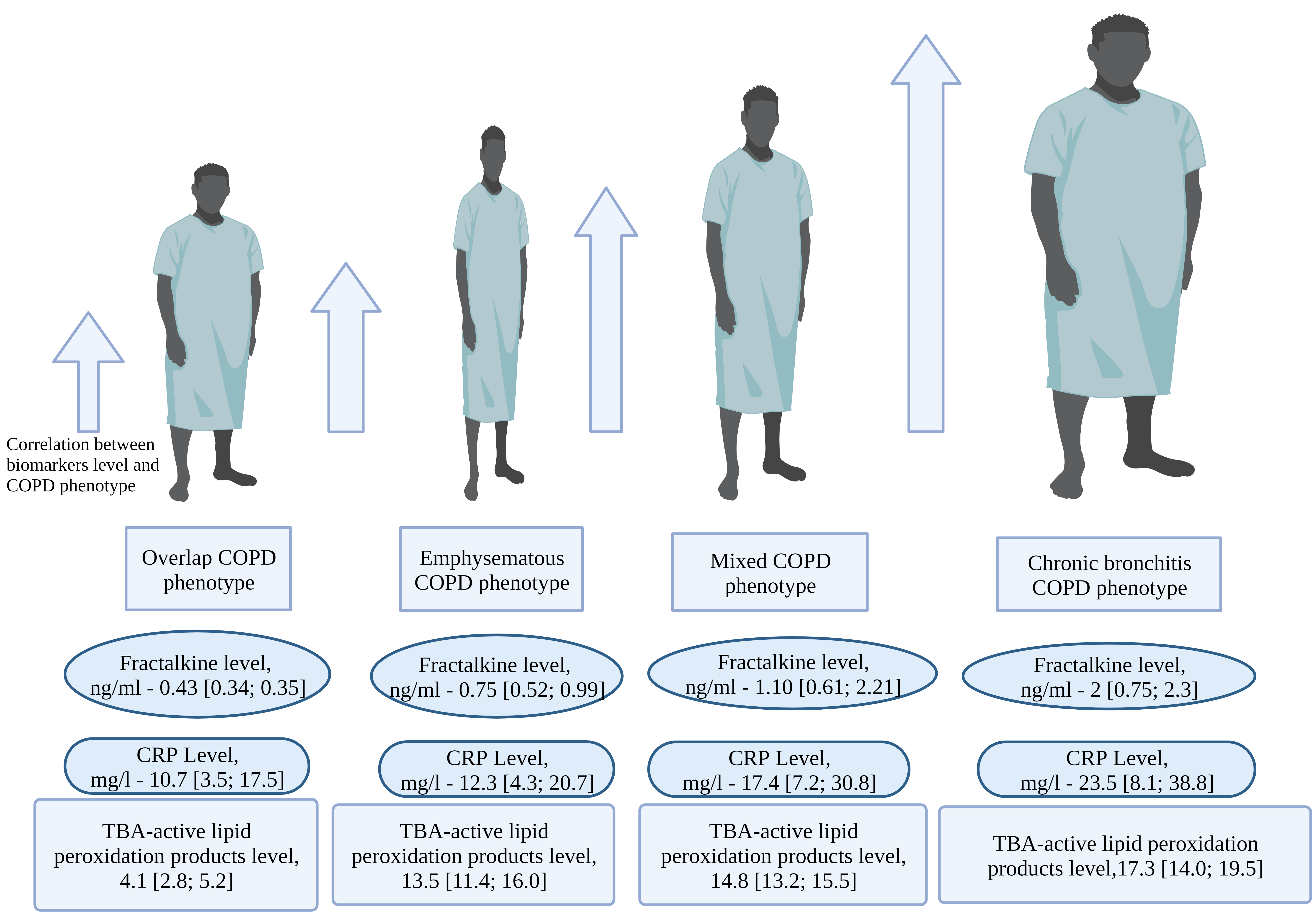Correlation analysis between inflammatory biomarkers and significant clinical phenotypes of chronic obstructive pulmonary disease
DOI:
https://doi.org/10.18413/rrpharmacology.9.10004Abstract
Introduction: Chronic obstructive pulmonary disease (COPD) is the leading cause of mortality. Using the evidence obtained about various clinical phenotypes of patients with the same disease allowed us to expand our understanding of the treatment of COPD. Nowadays the only option for solving the problem will be the definition of the clinical phenotype of COPD, and the receipt of expanded data on its correlation with respiratory and other significant biomarkers.
Materials and methods: We analyzed the correlations between FKN, CRP and TBA-active lipid peroxidation products in 373 patients with various COPD phenotypes and 60 healthy volunteers. Enzyme immunoassay was used to study the levels of inflammatory biomarkers.
Results: We have identified a statistically significant increase in the levels of inflammatory biomarkers in patients with COPD compared with the control. The FKN level in the group of patients with COPD was 1.3 ng/ml, which was higher (p<0.001) than in the control (FKN level of 0.3 ng/ml, p<0.001). The CRP level in patients with COPD was 27.8 mg/L, whereas in control the CRP level was 1.2 mg/L (p<0.001). The TBA-active lipid peroxidation products level in patients with COPD was 14.5 mmol/L, which was higher when compared to the control (p<0.001).
Discussion: The correlation analysis revealed very strong relationships between the levels of all the biomarkers studied. The highest values of the Kendall rank correlation coefficient (τ) were determined between the levels of all the inflammatory biomarkers in subgroups of patients with chronic bronchitis and mixed COPD phenotypes.
Conclusion: Detection of the COPD phenotype will help actively monitor the therapy of COPD exacerbations.
Graphical Abstract

Graphical Abstract

Keywords:
COPD , phenotyping, inflammationReferences
Agrawal R, Moghtader S, Ayyala U, Bandi V, Sharafkhanen A (2019) Update on management of stable chronic obstructive pulmonary disease. Journal of Thoracic Disease 11(14): S1800–S1809. https://doi.org/10.21037/jtd.2019.06.12 [PubMed] [PMC]
Agustí A, Vogelmeier C, Faner R (2020) COPD 2020: changes and challenges. American Journal of Physiology. Lung Cellular and Molecular Physiology 319(5): 879–883. https://doi.org/10.1152/ajplung.00429.2020 [PubMed]
Brat K, Svoboda M, Zatloukal J, Plutinsky M, Volakova E, Popelkova P, Novotna B, Dvorak T, Koblizek V (2021) The relation between clinical phenotypes, GOLD groups/stages and mortality in COPD patients – a prospective multicenter study. International Journal of Chronic Obstructive Pulmonary Disease 16: 1171–1182. https://doi.org/10.2147/COPD.S297087 [PubMed] [PMC]
Casas Herrera A, Montes de Oca M, López Varela MV, Aguirre C, Schiavi E, Jardim JR, PUMA Team (2016) COPD underdiagnosis and misdiagnosis in a high-risk primary care population in four Latin American countries. A key to enhance disease diagnosis: the PUMA Study. PLOS One 11(4): e0152266. https://doi.org/10.1371/journal.pone.0152266 [PubMed] [PMC]
Corlateanu A, Mendez Y, Wang Y, Garnica Ricardo dJA, Botnaru V, Siafakas N (2020) Chronic obstructive pulmonary disease and phenotypes: a state-of-the-art. Pulmonology 26(2): 95–100. https://doi.org/10.1016/j.pulmoe.2019.10.006 [PubMed]
Fermont JM, Masconi KL, Jensen MT, Ferrari R, Di Lorenzo VAP, Marott JM, Schuetz P, Watz H, Waschki B, Müllerova H, Polkey MI, Wilkinson IB, Wood AM (2019) Biomarkers and clinical outcomes in COPD: a systematic review and meta-analysis. Thorax 74(5): 439–446. https://doi.org/10.1136/thoraxjnl-2018-211855[PubMed] [PMC]
Halpin DMG, Criner GJ, Papi A, Singh D, Anzueto A, Martinez FJ, Agusti AA, Vogelmeier CF (2021) Global initiative for the diagnosis, management, and prevention of chronic obstructive lung disease. The 2020 GOLD Science Committee Report on COVID-19 and Chronic Obstructive Pulmonary Disease. American Journal of Respiratory and Critical Care Medicine 203(1): 24–36. https://doi.org/10.1164/rccm.202009-3533SO [PubMed] [PMC]
Hassan M, Mourad S, Wahab NHA, Daabis R, Younis G (2016) Effect of comorbidities on response to pulmonary rehabilitation in patients with chronic obstructive pulmonary disease. Egyptian Journal of Chest Diseases and Tuberculosis 65(1): 63–69. http://dx.doi.org/10.1016/j.ejcdt.2015.11.006
Hoffman EA, Lynch DA, Barr RG, van Beek EJR, Parraga G (2016) IWPFI Investigators. Pulmonary CT and MRI phenotypes that help explain chronic pulmonary obstruction disease pathophysiology and outcomes. Journal of Magnetic Resonance Imaging 43(3): 544–557. https://doi.org/10.1002/jmri.25010 [PubMed] [PMC]
Karayama M, Inui N, Yasui H, Kono M, Hozumi H, Suzuki Y, Furuhashi K, Hashimoto D, Enomoto N, Fujisawa T, Nakamura Y, Watanabe H, Takafumi S (2019) Clinical features of three-dimensional computed tomography-based radiologic phenotypes of chronic obstructive pulmonary disease. International Journal of Chronic Obstructive Pulmonary Disease 14: 1333–1342. https://doi.org/10.2147/COPD.S207267 [PubMed] [PMC]
Khalil MM, Dwedar AI, Abdelazeem MM (2019) Impact of chronic obstructive pulmonary disease on the outcome of patients admitted to the coronary care unit. The Egyptian Journal of Chest Diseases and Tuberculosis. 68: 123–128. https://doi.org/10.1155/2016/8212459
Manian P (2019) Chronic obstructive pulmonary disease classification, phenotypes and risk assessment. Journal of Thoracic Disease 11(14): S1761–S1766. https://doi.org/10.21037/jtd.2019.05.10 [PubMed] [PMC]
Vogelmeier CF, Romàn-Rodríguez M, Singh D, Han MK, Rodríquez-Roisin R, Ferguson GT (2020) Goals of COPD treatment: Focus on symptoms and exacerbations. Respiratory Medicine 166: 105938. https://doi.org/10.1016/j.rmed.2020.105938 [PubMed]
Downloads
Published
How to Cite
Issue
Section
License
Copyright (c) 2023 Research Results in Pharmacology

This work is licensed under a Creative Commons Attribution 4.0 International License.
 Русский
Русский
 English
English

